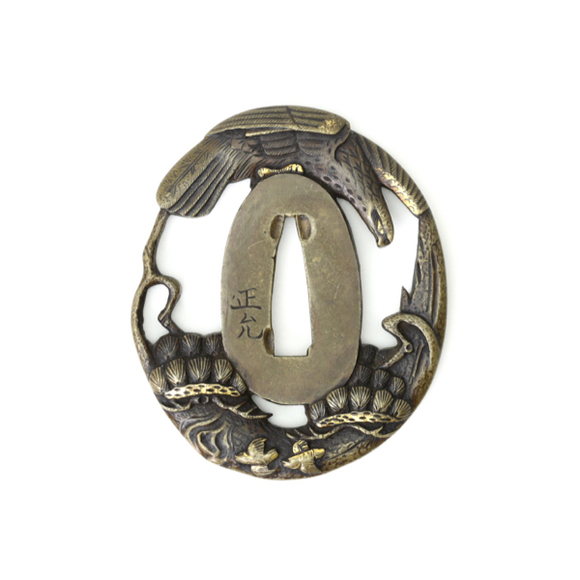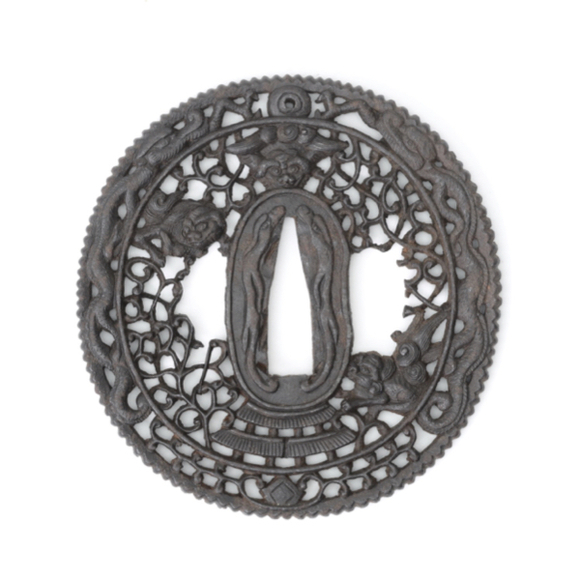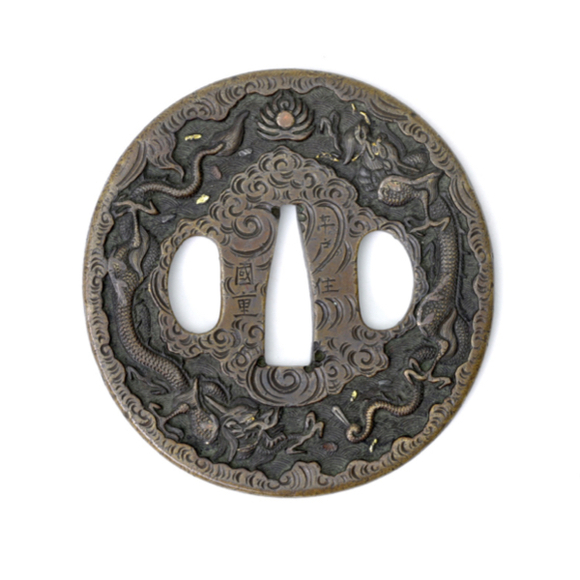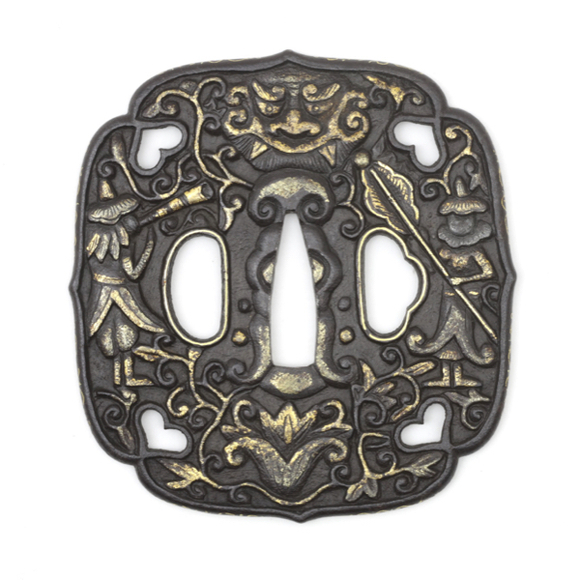Russet iron, one-piece construction with decorative grooves.

Blade 36.3 cm
Nagasa (edge) 26.3 cm
Base 5.2 cm
Tip 3.6 mm
Base 27 mm
171 grams
Shizu
Mino, Japan
Blade: Tempered steel
Mountings: Wood, urushi, ray-skin, buffalo horn, shakudō, gold, silk
14th century
Update April 2024
This blade is currently traveling in Japan, and will be submitted to the Juyō shinsa as Darcy once intended.
Introduction
Following the Genpei war, Minamoto no Yoritomo established himself as a shōgun and made Kamakura in Sagami (a.k.a. Sōshū) his capital. The Kamakura period would last from 1185-1333 and is seen as the golden age of Japanese bladesmithing. Kamakura at the time attracted some of the best smiths of Japan, who set up shop in the new capital in order to serve the new elite. Their interaction and innovation created a new and exciting style that is now known as the Sōshū school of Japanese bladesmithing. This is the school from which grandmaster Masamune emerged, widely regarded as Japan's best smith.
Many great smiths emerged at the time, for example, Norishige who was Masamune's peer under Shintogo Kunimitsu, and Masamune's adopted son Sadamune. Masamune is said to have had ten students. The composition of this list varies but almost always mentioned are Go-Yoshihiro and Kaneuji.
Blades by the Sōshū masters are prized possessions, then and now. They have been passed down among Japanese shōgun and daimyo, forming the highlights of their collections, and in modern times of private and museum collections.
A fine Sōshū tantō
Presented here is a very good, representative example of a Sōshū tantō of the second half of the 14th century.

Blade attributes
(With plain English below)
Nakago: Ubu. Mumei. Funa-gata with iriyamagata-jiri with slight katte-sagari yasurime. Nasu-hisago mekugi ana.
(Tang: Unaltered. Unsigned. "Ship shaped" with V-shaped end. Finished with slightly slanting file marks from upper left to lower right. Two overlapping peg holes in the form of an eggplant.)
Sugata: Hira-zukuri with wide mihaba. Mitsu mune.
(Overall form: Blade with flat sides and relatively wide base. Spine finished with three facets.)
Jigane: Standing out itame with masame along the ha.
(Steel: Mainly wood grain with straight grain in the hardened zone.)
Hamon: Ko-notare nie-deki with gunome, lots of sunagashi and kinsuji.
(Temperline: Undulating temperline executed in large, visible martensite crystals, with round elements and effects reminding of brush sand and black gleaming lines running through them.)
Boshi: Ko-maru with short kaeri.
(Temperline at tip: small circle turning point with short temperline along the back.)
It follows the classic design elements of the Sōshū school, including a mitsu-mune and the funa-gata ("ship shaped") nakago with kengyō-jiri tip that was first done by Masamune and then passed down to his students.
The horimono consist of a Buddhist sword (ken) on the left and a lotus and chopsticks on the right side, representing the opposites of forgiveness and punishment. Horimono like this were first carved into blades by Sadamune and were adopted by several other Sōshū smiths.
Seen in the gleaming light, the wild hamon reminds strongly of that of Masamune but is just slightly toned down. Clear dark chikei are seen and sprays of ji nie just above the hamon line.


Attributions
The tantō comes with two attributions: Takagi Sadamune and Naoe Shizu.
Attribution #1: Takagi Sadamune
Takagi Sadamune is found on an older shirasaya. Although not signed with his name, the format and handwriting are that of Hon'ami Kōson (1879-1955), Hon'ami sword polisher and appraiser and "father" of the Gokaden ("Five Traditions") classification system.
Thanks to Dmitry Pechalov for pointing this out in personal communication.
Another sayagaki by the same hand, this time signed by Hon'ami Kōson and dated to 1928 is found in his book:
Japanese Swords, Sōshū Den Masterpieces, 2019. Page 95.

It is signed:
高木貞宗
Takagi Sadamune
代金子貮百枚
Dai kinsu nihyaku-mai
"Valued at 200 gold coins"
長サ八寸七分有之
Nagasa hachisun nanabu ari more
"The length is 8 sun 7 bu" (26.4 cm)
On average, a gold coin was equivalent to a ryō, which was traditionally roughly the value of one Koku, the amount of rice needed to feed a person for a year. The blade was thus valued at the cost of food for 200 people for one year.
Takagi Sadamune was the successor of Sōshū Sadamune, Masamune's best student and adopted son.
Attribution #2: Naoe Shizu
The attribution to Naoe Shizu comes from the NBTHK's Tokubetsu Hozon papers, dated 26 of August in the 28th year of Heisei (2016):

Naoe Shizu is the Mino-based school of Kaneuji, one of Masamune's top students.
It shows that attributions of unsigned blades are not an exact science, and opinions can vary on who the exact maker was. Far less variety is seen in the estimation of the quality of the work, and so both attributions suggest the blade was made by a student of someone who was directly trained by Masamune himself.
Takagi Sadamune (高木住貞宗)
Masamune's best student is considered to have been Sadamune, which is perhaps why he adopted him as his son. Takagi Sadamune, in turn, is believed to have been Sōshu Sadamune's son and thus Masamune's legal grandson.
According to the Kotō Meizhukushi Taizen of 1792, Takagi Sadamune also trained directly with Masamune and became his disciple at age 35. He later trained and traveled with Sadamune. He took the name Takagi Sadamune when he became the head of his lineage after his father's passing.
Sōshu Sadamune forged an incredibly fine hada with lots of very fine ji nie. Takagi Sadamune worked in the style of Sōshū Sadamune, but his hada is less fine. Extant works appear primarily in the form of tantō, just like this one, and appear to date from around the 1360s.
His works are extremely rare, with only about 34 blades on record. A juyō Takagi Sadamune tantō is in the collection of Dmitry Pechalov and published in his Soshu Den Masterpieces. A tantō, now juyō bijutsuhin ("Important Work of Art") was once in the possession of Toyotomi Hideyoshi.
Sources:
Markus Sesko; Swordsmiths of Japan. Lulu Publishing, 2014. Pages 889-890.
Kotō Meizhukushi Taizen of 1792.
Dmitry Pechalov; Japanese Swords; Soshu Den Masterpieces. 2019. Pages 140-141 & 156-159
Naoe Shizu (直江志津)
Naoe Shizu is the school of Kaneuji (兼氏), one of Masamune's main students, and a saijo saku (grandmaster) rated smith.
His real name was Shizu Saburō (志津三郎), he lived from 1284-1344. Originally from Yurugi town in Yamato province, where he was trained in the Yamato Tegai school of bladesmithing by Tegai founder Kanenaga. He then moved to Nokami town, Fuwa district of Mino province, and became what is widely accepted as the founder of the Mino tradition.
In between Yamato and Mino, he is thought to have resided in Sagami, although no records of this exist. He is listed as one of Masamune's Jittetsu ("Ten Students"). Among them, he was considered the best, along with Norishige and Go Yoshihiro. (It is important to know that Sōshū Sadamune was not on this list of students because he is the successor.)
He finally moved to Shizu (志津) in the Tagi district of Mino 1335. Kaneuji's pupils moved to the village of Naoe (直江), and so the school became known as the Naoe-Shizu school. The main smiths of this group were:
Kanetomo (兼友), son of Kaneuji. Ō-wazamono, jōjō-saku.
Kanetsugu (兼次), son or student of Kaneuji. Jō-saku.
Kanenobu (兼信), son of Kaneuji. Chū-jō-saku.
Kanetoshi (兼俊). Jō-saku.
Sources:
Markus Sesko; Swordsmiths of Japan. Lulu Publishing, 2014. Pages 294-295.
Kotō Meizhukushi Taizen of 1792.
Dmitry Pechalov; Japanese Swords; Soshu Den Masterpieces. 2019. Pages 346-350
Further thoughts on attribution
This tantō was previously in the possession of the late Darcy Brockbank, a notable Japanese sword expert who sadly left our world prematurely. He felt that the Naoe Shizu designation was conservative, a safe call. He wrote:
"This blade was made unsigned and is ubu, but the condition of the end of the nakago jiri being kengyo is consistent with an older attribution to Soshu Sadamune. The blade does have a sayagaki on it which is unsigned attributing it to Takagi Sadamune. Takagi Sadamune was either the second generation Soshu Sadamune or else his son, as there are many stories of Sadamune moving to Goshu (Takagi) at the end of his career. Old oshigata books have many clean examples of this Takagi Sadamune mei but only one blade has survived to the present day. The sayagaki also values the blade very highly at 200 gold coins. Given the nakago, an attribution to Takagi Sadamune or Soshu Sadamune is not out of the question, but Takagi Sadamune's work tends to be a bit bigger and the hamon is more in keeping with Shizu Kaneuji.
The Imagawa Shizu which had this same structure had some contesting opinions about it being Shizu or Naoe Shizu, and in this case as Tanobe sensei would say “Naoe Shizu is safe harbor” meaning that it is a conservative call. I personally think that these very vivid works are more likely to be Kaneuji than they are to be his students. Especially in this case with the signed reference piece having such a strong resemblance in the hamon, it makes a strong argument. I put up the Kaneuji reference as well as a signed example of one of his students, Kanetomo, which is very typical for the Naoe Shizu school. In case you want to check my text, you can do so very easily with your eyes and judge which you think matches this work best. The Kanetomo in this case is Juyo Bijutsuhin and is itself a masterpiece. Even so the activity is not as intense as Shizu Kaneuji."

Shizu Kanetomo Juyō Bijutsuhin tantō.

Kaneuji, Tokubetsu Juyō
Published in Tokubetsu Juyō Tōken Nado Zufu 10, 1987

Takagi Sadamune, Important Artwork
Formerly owned by Toyotomi Hideyoshi
Published in Nihontō Jūyō Bijutsuhin Zenshū, vol 2, 1985, page 292

Nobukuni, Important Artwork
Student of Sōshū Sadamune
Published in Nihontō Jūyō Bijutsuhin Zenshū, vol 1, 1985, page 313

Sōshū Sadamune, National Treasure
Published in Kokuho Token Zufu, 1936

Sōshū tantō, unsigned
The subject of this article
I personally err more towards the direction of Sadamune's school, as indicated by the old sayagaki. This is mainly by virtue of the horimono and the shape of the nakago with the kengyō-jiri, which you don't often see among the works of Kaneuji and his Naoe Shizu school. In fact, even among the main Sōshū smiths, Masamune and Sadamune were the only ones to consistently work such a nakago jiri and through Sadamune, it was passed down to what are believed to be his sons, Hiromitsu and Tekagi Sadamune.
Tempering the hamon requires strict temperature control and timing, yet there is little so deliberate as filing a nakago to shape or carve a horimono. These elements point towards the Sadamune line, mainly Takagi Sadamune, and the workmanship on hada and hamon do not speak strongly against that.
Sadamune also taught a smith named Nobukuni. A tantō signed Nobukuni was awarded Jūyō Bijutsuhin (important artwork) in 1933 that again bears resemblance to our tantō.
(Also compare our blade to a Juyō Tekagi Sadamune at www.seikeido.com.)
Darcy toyed with the thought of taking the blade to Tanobe Michihiro for his expert opinion, and sending it in for a Juyō session to see if it would pass and if the attribution would change. If I still have it by January, it will continue along this path in 2024.
Koshirae
It comes in a fine set of tantō koshirae, its austere design is typical for fine tantō in notable Edo period collections. It features a red lacquered saya with buffalo horn throat- and endpieces. The wooden hilt is wrapped with white stingray skin, and with black buffalo horn pommel. Some small chips off the scabbard lacquer. Ray-skin on the grip may be more recent.


It carries a shakudō menuki with golden Paulownia mon on either side. This is the family crest of the Tokugawa ruling house of Japan at the time. The workmanship suggests it was probably done by their in-house metalworkers of the Gotō family.

A very similar koshirae with identical menuki holds a fine tantō by Yukimitsu, Masamune's father, in the Pechalov collection.
See Dmitry Pechalov; Japanese Swords, Sōshu Den Masterpieces. 2019. Page 77.
The kogatana carried in the saya has a fine shakudō kozuka with five Japanese mon.


The mon are, from top to bottom:
1. Kyumai sasa ("9 bamboo leaves"), Takenaka clan.
2. Marunouchi ni Futatsubiki ("two bars in a circle"), Ashikaga-clan vassals like the Hatakeyama, Imagawa and Hosokawa clans.
3. Marunisagarifuji "(wysteria in a circle"), Fujiwara clan.
4. Yotsume ("four eyes"), Okuyama clan.
5. Maru Migimitsu Domoe (three thunders counter-clockwise), among others Ryukyu.
Conclusion
This tantō is a very good representative example of Nanbokucho era (1336-1392) Sōshū work. It comes with two attributions, one to Takagi Sadamune and one to Naoe Shizu. Both, in essence, are students of grandmasters trained directly by Masamune and who appear in the top lists of Sōshū smiths.
Although the wear on the horimono suggests the blade has seen some polishing, the blade has retained its very lively hada and hamon and is by all means healthy and in excellent condition, especially considering it is probably about 650 years old. A testament to how well it has been cared for since the day it was made.
It comes in a classic formal tantō koshirae of the type that was during official duties and ceremonies.




























Unusual tsuba with foreign figures and Chinese auspicious symbols.






